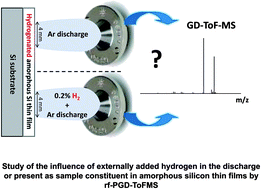Thin film solar cells technology based on hydrogenated amorphous silicon (a-Si:H) has undergone a great expansion during recent years. Pulsed radiofrequency glow discharge time-of-flight mass spectrometry (rf-PGD-ToFMS) is able to perform depth profiling analysis of coated materials, providing an excellent tool for rapid and high sensitive chemical characterisation of photovoltaic devices. The hydrogen concentration on a-Si:H thin films is around 10%, which represents a challenge for quantitative depth profile analyses by using GD sources due to the so-called “hydrogen effect”. It is well-known that when hydrogen is present in the Ar discharge, even in small quantities, significant changes can occur in the ion signal intensities and sputtering rates measured. Therefore, a critical comparison has been carried out by rf-PGD-ToFMS in terms of pulse profiles, spectral interferences and depth resolution for two modes of hydrogen introduction in the discharge, exogenous hydrogen in molecular gaseous form (using the mixture 0.2% H2 + Ar as discharge gas) or endogenous hydrogen, sputtered as a sample constituent. For this purpose, non-hydrogenated materials (containing B, P and Si) and three types of a-Si:H thin films were investigated. Exogenous hydrogen was found to produce a noteworthy influence on the pulse profiles of the analytes, whereas the effect of the hydrogen sputtered from the samples could be considered less notorious. Moreover, the proper selection of the after-peak region was found to be critical to obtain optimum mass spectra (i.e. high analyte sensitivities free of interferences).

You have access to this article
 Please wait while we load your content...
Something went wrong. Try again?
Please wait while we load your content...
Something went wrong. Try again?


 Please wait while we load your content...
Please wait while we load your content...